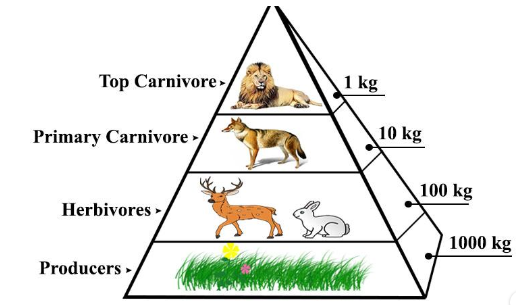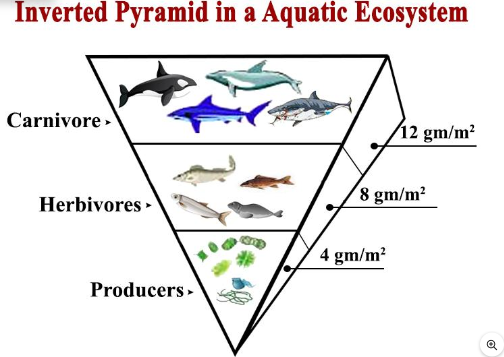JEE Main Important Physics formulas
ApplyAs per latest 2024 syllabus. Physics formulas, equations, & laws of class 11 & 12th chapters
Biomass can be defined as an ecosystem or environment where various types of living organisms are found. It involves a producer, a list of consumers, and finally, a decomposer. It can also be defined as the mass of one or more species (species biomass) or the group of all species living in a colony (community biomass). Biomass includes all microorganisms, plants and animals.
In terms of ecology, biomass is defined as the total population of all the living organisms existing in a given ecosystem at a given time. Why you measure biomass determines the parameters for calculating biomass in your area. Generally, biomass is calculated as the total natural mass of an organism. However, other applications consider only the tissue mass of an organism and exclude bones, teeth, horns, and shells. Some other calculations calculate the mass of organically bound carbon atoms (C).
There are 6 main parts of a biome:
Desert Biome: These are hot, dry regions that cover about 20% of the Earth's total land area. They are further divided into semi-arid, hot and arid, and cold and coastal deserts.
Forest Biome: Composed chiefly of carbon storage trees and plantations, it covers about 30% of Earth's total land area. These are further subdivided into temperate, tropical and boreal forests.
Aquatic Biome: These bodies of water are on the Earth's surface and comprise about 75% of the entire planet. They are classified into freshwater and marine biomes.
Tundra Biome: This is the coldest terrestrial biome and has very little biodiversity. They are subdivided into alpine tundra and arctic tundra biomes.
Grassland Biome: This represents a broad range of grass species with few or no trees. They are subdivided into temperate grasslands and savannas.
Shrubland or Chaparral Biome mainly refer to shrubs that are dry and hot in summer and wet and cool in winter. They are only found in a few parts of the world.
A biomass pyramid is a graphical representation of the different types of biomass per unit area at different trophic levels. The two main types of biomass pyramids are inverted pyramids and vertical pyramids. The biomass pyramid is essential for quantifying available biomass at each trophic level.
Terrestrial biomass includes ecosystems on land. The base of the ecological pyramid consists of plants that contribute the most to total biomass. Some examples of these producers are lawns, shrubs, and trees. These plants have higher biomass than consumers who eat cattle, zebras, giraffes, buffaloes, deer, and small insects. Secondary consumers such as tigers, lions, bears, and snakes have less biomass than primary consumers. In pasture ecosystems, grasses are the primary producers. The biomass pyramid is most comprehensive at the bottom and narrows at the top.

In Ocean biomass, phytoplankton is producers. They reproduce rapidly but are short-lived. The primary consumers, zooplankton, have more biomass than phytoplankton, turning the pyramid of marine biomass upside down. Zooplankton is the most significant contributor to the total biomass of marine ecosystems. Tertiary consumers such as herring and krill have lower biomass than zooplankton. The fourth trophic level includes predatory fish such as seals, gannets, and swordfish. The pyramid tips off with the apex predators like the baleen whales or the shortfin mako sharks.

According to a recent study conducted by the Ministry of New and Renewable Energy (MNRE), the Government of India, the current availability of total biomass in India is estimated at 750 million metric tons per year, which is about 230 million metric tons per year.
The benefit of biomass are:
Biomass provides a relatively clean, free, reliable and sustainable renewable energy source.
This helps reduce waste.
Reduces pollution by not introducing additional carbon into the environment.
This requires a lot of initial setups.
Requires ample operating space. Offers low efficiencies compared to fossil fuels.
Biomass energy helps protect the environment because the amount of carbon dioxide released when burning biomass-derived fuels is comparable to the amount captured by plants during photosynthesis. Therefore, it can be considered a carbon-neutral process. However, some pollutants are released during the conversion of biomass into bioenergy.
In terms of ecology, biomass can be defined as the various living organisms found in an ecosystem or environment. It consists of a producer, a list of consumers, and finally, the decomposers.
Biomass energy helps protect the environment because the amount of carbon dioxide released when burning biomass-derived fuels is comparable to the amount captured by plants during photosynthesis. Therefore, it can be considered a carbon-neutral process. However, some pollutants are released during the conversion of biomass into bioenergy.
The limitations of biomass are:
This requires a lot of initial setups.
Requires ample operating space.
Offers low efficiencies compared to fossil fuels.
The pyramid of biomass refers to the graphical representation of different kinds of biomass present in a unit area at multiple trophic levels. The two main types of biomass pyramids are inverted pyramids and vertical pyramids. The biomass pyramid is essential for quantifying available biomass at each trophic level.
Terrestrial biomass includes ecosystems on land. The base of the ecological pyramid consists of plants that contribute the most to total biomass. Some examples of these producers are lawns, shrubs, and trees. These plants have higher biomass than consumers who eat cattle, zebras, giraffes, buffaloes, deer, and small insects. Secondary consumers such as tigers, lions, bears, and snakes have less biomass than primary consumers. In pasture ecosystems, grasses are the primary producers. The biomass pyramid is most comprehensive at the bottom and narrows at the top.
Apr 27, 2022 - 12:42 p.m. IST ---STATIC
Apr 27, 2022 - 12:42 p.m. IST ---STATIC
Apr 27, 2022 - 12:42 p.m. IST ---STATIC
Apr 27, 2022 - 12:42 p.m. IST ---STATIC
Apr 27, 2022 - 12:42 p.m. IST ---STATIC
Apr 27, 2022 - 12:42 p.m. IST ---STATIC
Apr 27, 2022 - 12:42 p.m. IST ---STATIC
Apr 27, 2022 - 12:42 p.m. IST ---STATIC
Apr 27, 2022 - 12:42 p.m. IST ---STATIC

As per latest 2024 syllabus. Physics formulas, equations, & laws of class 11 & 12th chapters

Register FREE for ALLEN Digital Scholarship Admission Test (ADSAT)

Get up to 90% scholarship on NEET, JEE & Foundation courses

As per latest 2024 syllabus. Chemistry formulas, equations, & laws of class 11 & 12th chapters

Start your JEE preparation with ALLEN

Enrol in PACE IIT & Medical, Financial District, Hyd for JEE/NEET preparation